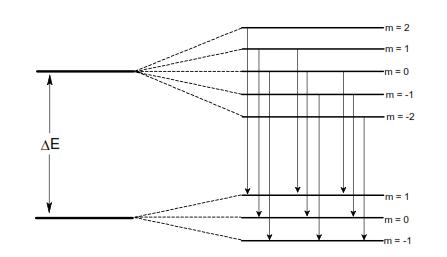13.3: Solar Weather
( \newcommand{\kernel}{\mathrm{null}\,}\)
 A closeup view of a sunspot.
A closeup view of a sunspot.
 Sunspots appear as dark blemishes on the surface of the Sun.
Sunspots appear as dark blemishes on the surface of the Sun.
13.3.1 Sunspots
Galileo was one of the first scientists to notice dark blemishes on the surface of the sun. These sunspots appear dark because they are slightly cooler than their surroundings. By Earth standards, they are actually very hot, with temperatures about 4000 K. Sunspots are regions with strong magnetic fields. We can measure magnetic fields in sunspots by observing the splitting of spectral lines. Known as the Zeeman Effect, it is the result of strong magnetic fields splitting a single spectral line into three separate lines.
 The intense magnetic fields of a sunspot causes spectral lines to split into three separate lines.
The intense magnetic fields of a sunspot causes spectral lines to split into three separate lines.
Sunspots occur in pairs that are linked by magnetic field lines. In a sunspot pair, one spot has a north pole and the other acts as a south pole. Charged particles spiral around the magnetic field lines connected the two spots. These particles emit radiation, making the field lines detectable as loops of bright gas travel along the lines. Sunspot come and go over a period of a few days as they appear, move across the face of the Sun, and then disappear.
 Sunspot flares produce magnetic field lines that can be seen through their affect on ionized gases.
Sunspot flares produce magnetic field lines that can be seen through their affect on ionized gases.
 Solar Flares
Solar Flares
https:/www.flickr.com/photos/sdomission/12525560223;
Sunspots are produced by distortions in the Sun’s magnetic field. As the Sun rotates, it drags magnetic field lines around with it, causing kinks in which the lines twist up, creating magnetic storms on the surface.
The Sun has an 11-year sunspot cycle, during which sunspot numbers rise, fall, and then rise again. The cycle is really a 22-year cycle because the spots switch polarities between the Northern and Southern Hemispheres every 11 years. The solar corona also changes with the sunspot cycle. It is much larger and more irregular at sunspot peak.

The Solar cycles over the past 1000 years.
Curiously, during the late 1600s and 1700s, the Sun went through a period of relatively low sunspot activity. During this Maunder minimum, there were few, if any, sunspots.
13.3.2 Solar Storms
Areas around sunspots are active and may be associated with large eruptions in the photosphere. Sunspots and other magnetic activity on the Sun’s surface can create solar prominences, large sheets of ejected gas that erupt high about the Sun’s surface. Prominences can last for several days or weeks.
 A solar prominence is a plume of gas erupting from the surface.
A solar prominence is a plume of gas erupting from the surface.
https:/www.flickr.com/photos/lightsinthedark/5821379923;
Magnetic activity can also cause solar flares that send bursts of X-rays and charged particles into space. A solar flare is a large explosion on the Sun’s surface, emitting an amount of energy. Flares appear similar to prominences but last for seconds or minutes rather than days or weeks.
Occasionally, the Sun will emit are large blob of hot plasma. This coronal mass ejection emits charged particles out through the Solar System and has a strong magnetic field that can affect Earth. If a coronal mass ejection interacts with the Earth’s magnetic field, it can disrupt satellite communications or even damage the electric grid, causal a global blackout.
 A coronal mass ejection is a mass of ionized gas released from the Sun.
A coronal mass ejection is a mass of ionized gas released from the Sun.
https:/commons.wikimedia.org/wiki/File:Magnificent_CME_Erupts_on_the_Sun_-_August_31.jpg;
 The solar wind originates from coronal holes, which are dark, V-shaped regions as pictured here.
The solar wind originates from coronal holes, which are dark, V-shaped regions as pictured here.
https:/www.flickr.com/photos/sdomission/32307510758;






